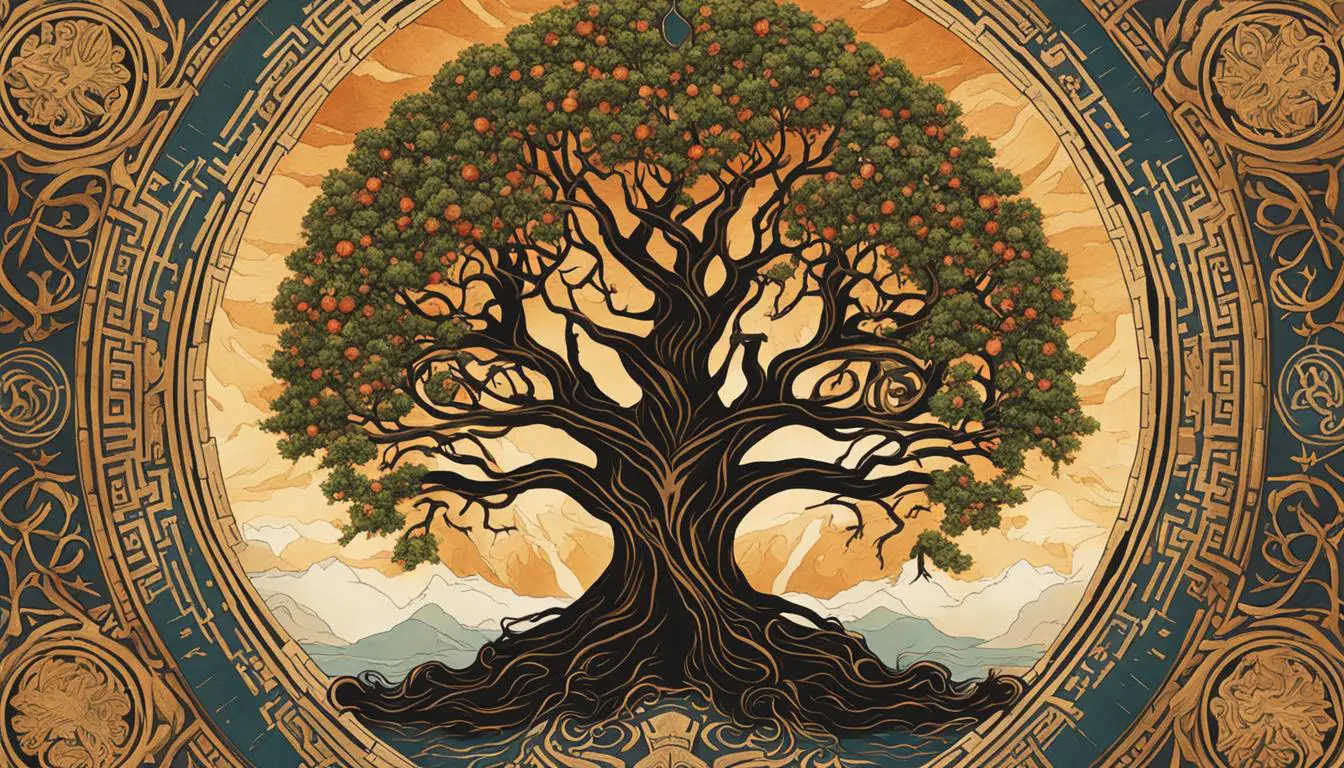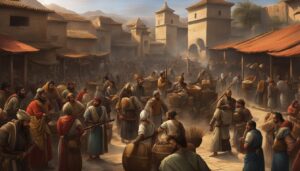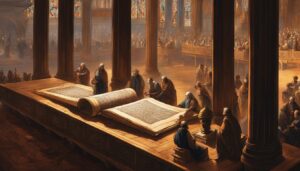
Christian mythology is the body of myths associated with Christianity. Throughout Christian literature, mythological themes and elements can be found, including stories of ascending mountains, descending into the Underworld, accounts of dying-and-rising gods, and tales of great heroes from the past. Authors have also used mythology and allegorical elements from the Bible to refer to myths and legends from the Middle Ages. There are intriguing connections between ancient Greek mythology and biblical history, with similarities between the first woman Eve and the Greek mythological figure Pandora. The Bible also features a strong man, Samson, who shares similarities with the legendary figure Hercules. Additionally, both the Bible and Greek mythology mention the existence of giants, known as the Nephilim in the Bible, and demigods in Greek mythology.
Key Takeaways:
- Christian literature contains mythological themes and elements.
- Ancient Greek mythology and biblical history share similarities.
- The Bible features the first woman, Eve, and Greek mythology features Pandora.
- Both the Bible and Greek mythology include strong men, Samson and Hercules.
- Giant figures and demigods are mentioned in both the Bible and Greek mythology.
The First Woman in Mythology and the Bible
The Bible and Greek mythology both feature stories about the first woman, Eve and Pandora, respectively. These tales share similarities and provide insights into the origins of humanity and the introduction of evil into the world.
In the Bible, Eve is created from Adam’s rib and is tempted by a serpent to eat fruit from the forbidden tree of knowledge. Her actions result in the fall of man and the introduction of sin and evil into the world. Similarly, in Greek mythology, Pandora is created by the gods and given a box containing all the world’s evils. She succumbs to curiosity and opens the box, unleashing chaos and suffering onto the world.
“Out of the woman comes forth the beginning of sin, and through her we all die.” – Ecclesiasticus 25:24
These stories highlight the themes of temptation, choice, and the consequences of human actions. They remind us of the frailty of human nature and the presence of evil in the world, while also emphasizing the importance of free will and personal responsibility.
Comparison of Eve and Pandora:
| Eve | Pandora | |
|---|---|---|
| Creation | Created from Adam’s rib | Created by the gods from water and earth |
| Temptation | Tempted by a serpent to eat fruit from the forbidden tree | Given a box containing all the world’s evils, opens it out of curiosity |
| Consequences | Introduction of sin and evil into the world | Release of chaos and suffering onto the world |
Despite their differences, the stories of Eve and Pandora serve as cautionary tales and remind us of the importance of making wise choices and resisting temptation.
The Strong Man: Samson and Hercules
Both the Bible and Greek mythology feature legendary figures known for their incredible strength. Samson, a biblical character, was chosen by God to deliver the Israelites from the Philistines and possessed extraordinary physical power. Hercules, a demigod in Greek mythology, also exhibited superhuman strength and was renowned for his twelve labors.
Samson’s strength was a divine gift, and he used it to achieve great feats of valor. One of his most famous stories involves him killing a lion with his bare hands. In another instance, he single-handedly defeated a thousand Philistine soldiers using only the jawbone of a donkey as a weapon.
Hercules, on the other hand, was the son of Zeus, the king of the gods, and a mortal woman. His incredible strength allowed him to complete a series of seemingly impossible tasks, including slaying the Nemean lion, capturing the Golden Hind, and defeating the nine-headed Hydra.
“Great strength is both a blessing and a burden. Samson and Hercules exemplify the immense power that can be wielded by a strong man. However, their strength also brought them great challenges and ultimately led to their downfall.”
Although Samson and Hercules lived in different times and cultures, their stories share similarities that highlight the enduring fascination with powerful individuals in human mythology. These legendary characters continue to captivate audiences with their extraordinary abilities and the trials they faced throughout their lives.
The Similarities Between Samson and Hercules:
- Both possessed superhuman strength.
- They were chosen for their respective tasks by divine or godly entities.
- They faced numerous challenges and adversaries.
- Their strength was both a blessing and a curse.
- Both experienced tragic ends.
The Differences Between Samson and Hercules:
- Samson’s strength was derived from his commitment to God, while Hercules inherited his strength as a demigod.
- Samson’s story is rooted in biblical history, while Hercules’ exploits are part of Greek mythology.
- Samson’s strength was primarily utilized to protect the Israelites, while Hercules’ labors were feats undertaken to atone for his past actions.
- The cultural and religious contexts of their stories differ, with Samson’s tale emphasizing divine intervention and Hercules’ adventures exploring the nature of heroism.
| Samson | Hercules |
|---|---|
| Chosen by God to deliver the Israelites from the Philistines | Son of Zeus and a mortal woman |
| Defeated a lion with his bare hands | Slain the Nemean lion |
| Overcame a thousand Philistine soldiers | Completed twelve labors |
| Tricked by Delilah and captured by the Philistines | Driven to madness by Hera and committed acts of violence |
| Pulled down the pillars of a temple, causing his demise | Ascended to Mount Olympus after his death |
The tales of Samson and Hercules serve as reminders of the enduring appeal of strong men in mythology. Their stories not only entertain but also explore the complexities of power, heroism, and the human condition.
Giants in Mythology and the Bible
In both Greek mythology and the Bible, the existence of giants is a fascinating theme that captures the imagination. In the Bible, these giants are referred to as the Nephilim and are said to have lived before and after the Great Flood. Greek mythology, on the other hand, depicts demigods – the offspring of gods and mortals – who often possess extraordinary strength and stature. The presence of giants and demigods in both mythologies points to a shared fascination with larger-than-life figures in ancient storytelling.
The Nephilim, as described in the Bible, were believed to be the offspring of angels and human women. These giants were known for their exceptional size and power, which struck fear into the hearts of many. Their existence before the Flood is mentioned in various biblical texts, including the book of Genesis. Some theories suggest that the Nephilim may have also survived the Flood, leading to their presence after this cataclysmic event.
In Greek mythology, demigods were heroes with divine parentage and exceptional physical abilities. They were often depicted as towering figures, surpassing regular mortals in strength and prowess. These demigods, such as Hercules, were the embodiment of physical power and undertook remarkable feats and quests. Their epic adventures and larger-than-life personas continue to captivate audiences to this day.
The presence of giants and demigods in both mythologies highlights the universal human fascination with extraordinary beings. Whether found in ancient religious texts or epic tales of heroic exploits, the existence of these powerful figures raises questions about our own potential and the boundaries of human capability.
FAQ
Are there mythological elements in the Bible?
Yes, mythological themes and elements occur throughout Christian literature, including recurring myths such as ascending a mountain, descent into the Underworld, accounts of a dying-and-rising god, and stories about great heroes of the past.
Are there connections between Greek mythology and biblical history?
Yes, there are similarities between the first woman Eve and the first woman in Greek mythology, Pandora. The Bible and Greek mythology also feature strong men like Samson and Hercules, as well as the mention of giants and demigods.
Who was the first woman in the Bible and Greek mythology?
In the Bible, the first woman was Eve, who was created from Adam’s rib. In Greek mythology, the first woman was Pandora, who was created from water and earth and given a box containing all the world’s evils.
Who were the strong men in the Bible and Greek mythology?
The Bible features Samson, a man chosen by God and known for his incredible strength. Greek mythology includes Hercules, a demigod famous for his superhuman strength and his twelve labors.
Are there giants in both mythology and the Bible?
Yes, the Bible mentions the Nephilim, who are referred to as giants and are said to have existed before and after the Flood. Greek mythology features demigods, who are often larger-than-life figures.








